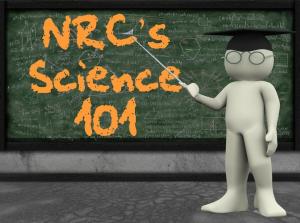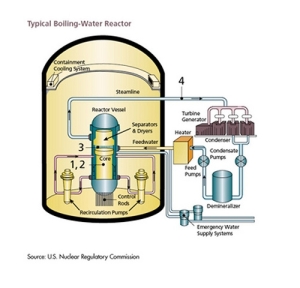 How does a nuclear reactor generate electricity? Well — it doesn’t, really. Let’s begin at the end and see how it all fits together.
How does a nuclear reactor generate electricity? Well — it doesn’t, really. Let’s begin at the end and see how it all fits together.
We begin by looking at an electric motor. A motor consists primarily of two major components: a stator, which stands still, and a rotor, which rotates within the stator. When electricity is applied to the motor, electromagnets within the stator and the rotor push and pull on each other in a way that causes the rotor to rotate. The magnets in the stator pull magnets in the rotor toward them, and then, as the rotor magnets pass by reverse themselves and push the rotor magnets away.
The parts are arranged so the pulling and pushing are all in the same direction, so the rotor spins inside the stator. The electrical energy applied to the motor results in mechanical energy in the rotor.
But that same machine can be used in reverse: If some outside force causes the rotor to spin, the interaction of the magnets causes electricity to be produced: the “motor” is now a “generator,” producing electrical energy as a result of the mechanical energy applied to its rotor. That’s the most common way to make large quantities of electricity.
So how do you make the rotor spin? That’s where the nuclear reactor comes in, although still indirectly. Recall that a nuclear reactor generates heat. The fuel rods get hot because of the nuclear reaction. That heat is used to boil water, and the steam from that boiling water is used to spin the rotor. As we have seen, when the rotor spins, electricity comes out of the stator.
When water boils, the steam that is produced occupies much more physical space than the water that produced it. So if you pump water through some sort of a heat source — like a nuclear reactor, or a coal‑fired boiler — that is hot enough to boil the water, the exiting steam will be travelling much faster than the water going in. That steam runs through a machine called a turbine, which acts something like a highly‑sophisticated windmill. The physical structure is vastly different from a windmill, and a large turbine can be far more powerful than any windmill that has ever been made, but the effect is somewhat the same: the steam, or wind, causes part of the machine to spin, and that spinning part can be connected to a generator to produce electricity.
The steam leaving the turbine is collected in a device called a condenser — essentially a metal box the size of a house, with thousands of pipes running through it. Cool water flows through the pipes, and the steam from the turbine is cooled and condenses back into water. Then the water is pumped back through the heater and the cycle continues.
Now, back to the nuclear reactor . . . We have seen how the reactor generates heat, and we have seen how heat is used to generate steam and how the steam then powers the turbine, which spins the generator that produces electricity. The final piece in the puzzle is how the heat from the nuclear reaction generates the steam.
 The fuel rods are suspended in a water bath contained in a large metal container somewhat like a gigantic pressure cooker. A typical “reactor vessel” might be 15 feet in diameter and 20 feet high, and some are much larger than that. In some types of reactors, the water is allowed to boil, and the heat generated in the fuel rods is carried away in steam. These are called “boiling water reactors” (or “BWR”).
The fuel rods are suspended in a water bath contained in a large metal container somewhat like a gigantic pressure cooker. A typical “reactor vessel” might be 15 feet in diameter and 20 feet high, and some are much larger than that. In some types of reactors, the water is allowed to boil, and the heat generated in the fuel rods is carried away in steam. These are called “boiling water reactors” (or “BWR”).
In others, the water is held at a very high pressure — on the order of 2000 pounds per square inch. (By the way, that is more than 60 times the pressure in the tires of a typical car.) In that situation, the water cannot expand and cannot boil. The water in that type of reactor carries the heat away while remaining liquid, and that heat is then transferred to another water system where the boiling occurs. This transfer takes place in a device aptly named a “steam generator.”
These are called “pressurized water reactors” (or “PWR”). A small PWR might have two steam generators. A large one might have four. Some have three. The steam from all of the steam generators is typically combined into a single “main steam line” that carries the steam to the turbine, so the reactor and all of the steam generators act together as a single steam source.
The water from the condenser is pumped directly into the reactor vessel for a BWR, or into the steam generators for a PWR.
So there you have it: the nuclear reaction heats the fuel, the fuel heats the water to make steam, the steam spins the turbine, the turbine turns the generator, and the generator makes electricity.
The author has a BS in Electrical Engineering from Carnegie-Mellon University.

Gain lots of information about generating electricity from nuclear reactor.
This blog post had a very narrow focus as part of our NRC Science 101 series. However, there are many blog posts about the nuclear accident at Fukushima and other safety-related subjects. Here are a few:
https://public-blog.nrc-gateway.gov/2011/03/page/3/
https://public-blog.nrc-gateway.gov/2011/05/27/lessons-learned-from-japan-and-elsewhere/
https://public-blog.nrc-gateway.gov/2013/06/04/before-the-browns-ferry-fire-antiquated-notions-that-electricity-and-water-didnt-mix/
https://public-blog.nrc-gateway.gov/2012/02/16/nrc-talking-research-next-week-in-virginia-pennsylvania/
The NRC’s website has additional discussions on Three Mile Island:
http://www.nrc.gov/reading-rm/doc-collections/fact-sheets/3mile-isle.html
Chernobyl:
http://www.nrc.gov/reading-rm/doc-collections/fact-sheets/chernobyl-bg.html
and Fukushima:
http://www.nrc.gov/reading-rm/doc-collections/fact-sheets/japan-events.html
Scott Burnell
Perhaps you missed the title of this piece. This is an elementary summation of how the technology actually works. It’s not meant to be a speculative dissertation on some vague scenario of your choosing. If your day is not complete without a dose of baseless fear-mongering written by the oil company shills, just call up one of the innumerable sites littered with such trash, curl up in the fetal position, and revel in your “nightmare.”
loved it, learnt a lot about nuclear reactors in one article than i have in a whole lofe-time. making science easy
I’d suggest that the NRC use San Onofre Unit 2 and Unit 3 Reactors as a textbook example of what happens when nuclear steam generators are not designed with a full review by seasoned steam generator experts, since it put all of Southern California at risk of a nuclear incident or worse a nuclear accident. Once people understand that leaking and/or ruptures of any significant number of the steam generator tubes located inside the steam generators cannot only rapidly drain the reactor of its core coolant (if a major industrial accident occurs) but it could also allow that massive amount of radioactivity to escape to the asmosphere, since inside each steam generator at San Onofre there were 9,747 tubes packed far to close together, each with a wall thickness of less than a credit card.
FACT: San Onofre has more tube damage than all the rest of the US reactors, put together! Here is a chart listing the staggering amount of tube damage that occurred in the short time that San Onofre was in operation after these “replacement” steam generators were installed:
Click to access steamgeneratortubesplugged1.pdf
Here is an industry article where both SCE and MHI’s engineers bragged about all the changes they “got away with” using the flawed “Like For Like” loophole that has still not been sealed by the NRC, or even the Inspector Generals review of San Onofre, which failed to pin point exacting what happened at San Onofre! BTW: This article was published the very same month that San Onofre started leaking and was shut down…
Click to access col-nrc-tech-paper.pdf
Well Said. Educating people about Nuclear should include not just Pro-Industry discussions, since nuclear generation has been proven to have risks that mankind cannot ignore.
Excellent fundamental discussion of how a nuclear reactor generates electricity. How about follow-up discussions about how a nuclear reactor can generate a public nightmare! Or “How a Nuclear Reactor Can Generate a Nuclear Melt-down”! For example, boil down, pun intended, the accidents at Three Mile Island, Chernobyl, and Fukushima. As our industry’s nuclear “watchdog” you really should discuss both sides of this nuclear reactor coin.